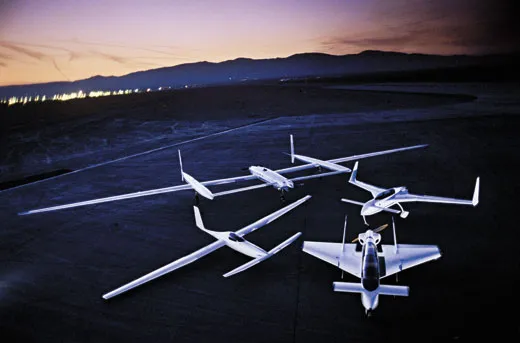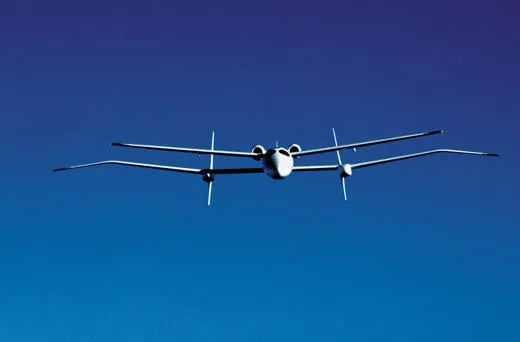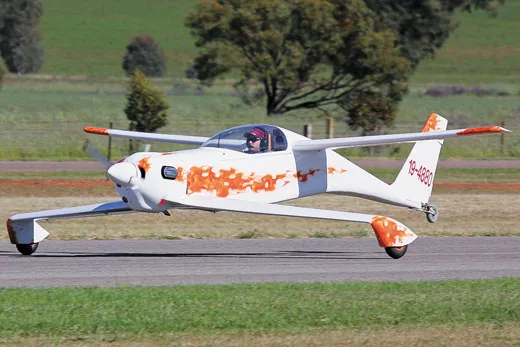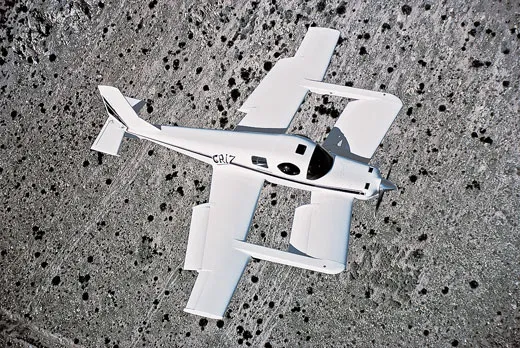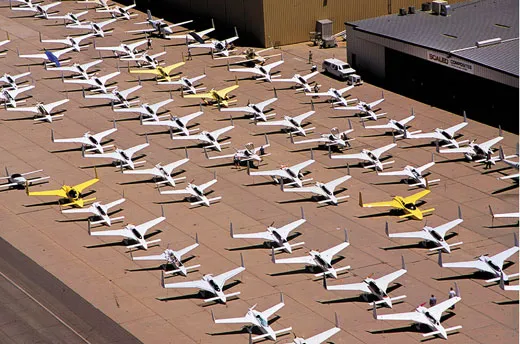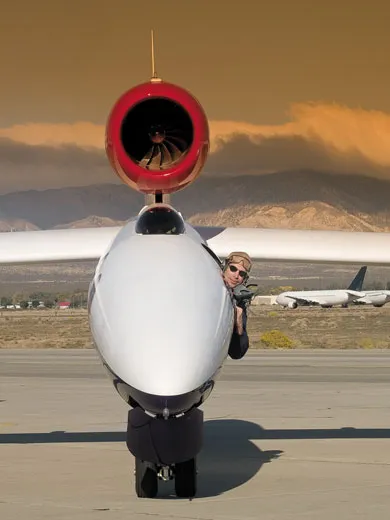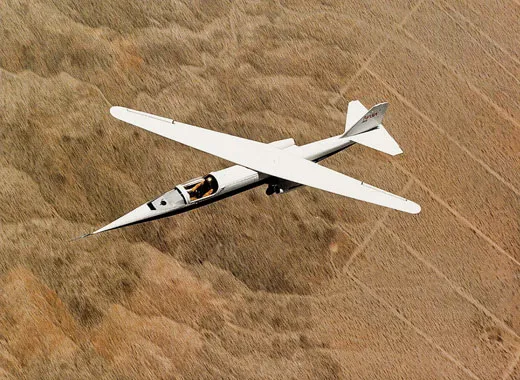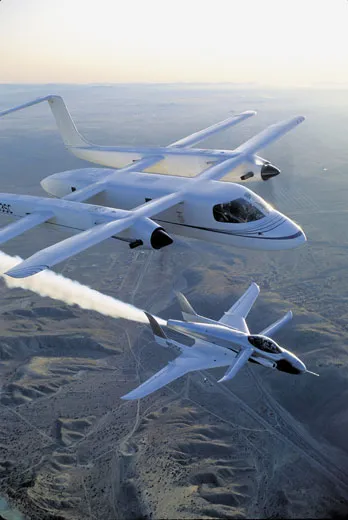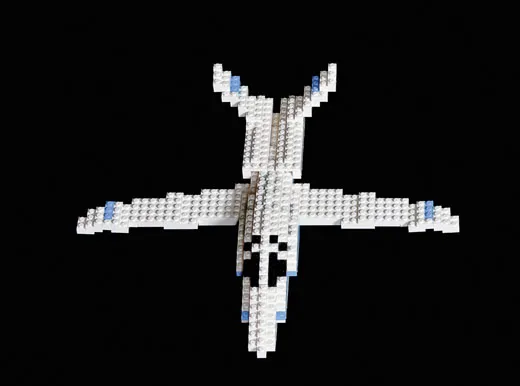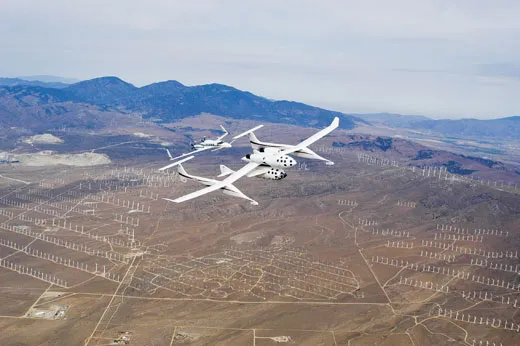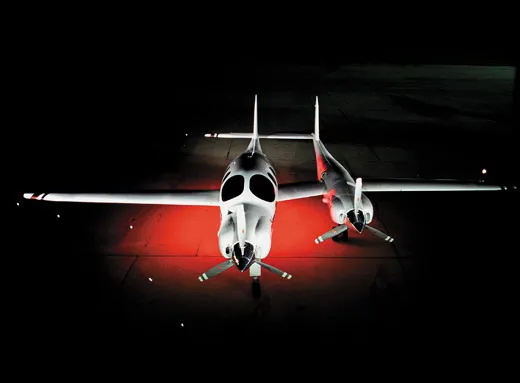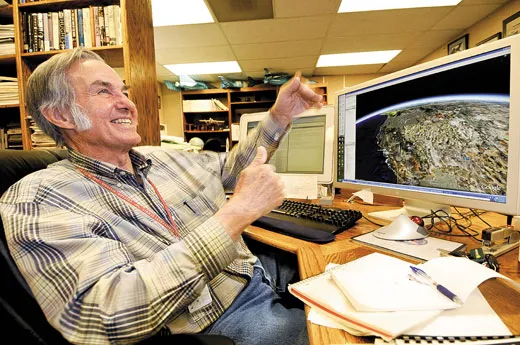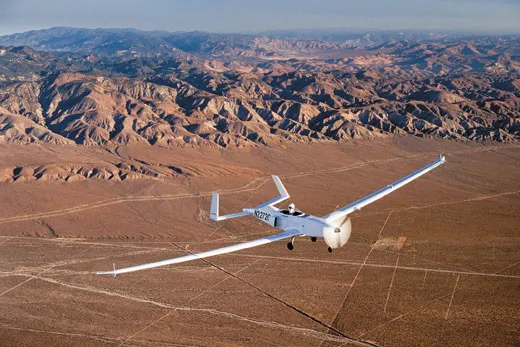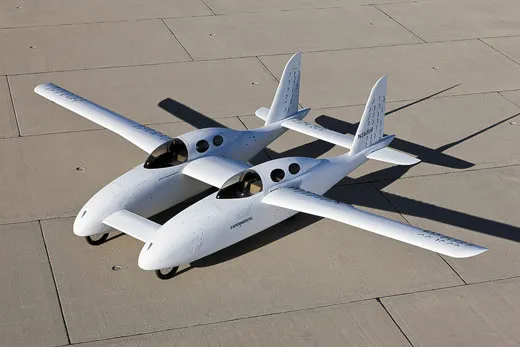A retrospective of Burt Rutan’s high-performance art
Design by Rutan
/https://tf-cmsv2-smithsonianmag-media.s3.amazonaws.com/filer/Design-Rutan-Proteus-FLASH.jpg)
You can always tell a Burt Rutan airplane, just as you can always tell a Dr. Seuss drawing or a Beatles song. It’s not only the configurations — though canards, winglets, or twin booms sometimes give them away. It’s not just the materials, though composites have been key to Rutan’s achievements and helped make him the hero of the homebuilder. And it’s not just the futurism, though Rutan designs always look like they flew in from a decade off in the distance. There’s some other quality rolled up with those three that makes you know it’s a Rutan. We think of it as playfulness.
Consider SpaceShipOne, Rutan’s best-known creation, which made history in 2004 as the world’s first private spaceship. It looks the way it does for sound engineering reasons: Its famous tail feathers were deployed to slow and control its atmospheric reentry, its tubby fuselage has a diameter of five feet to accommodate an oxidizer tank of similar dimension and a comfortable cabin, and its pointy little nose is sprinkled with small round windows so that the pilot could see the horizon at all times during the flight up to 60 miles and back. But SpaceShipOne is also toy-like. Can anyone doubt kids would be delighted by a small model of it?
Last April, Rutan retired from Scaled Composites, the California company he founded in 1982 (10 years after designing his first full-scale airplane), leaving a legacy of 38 piloted craft, among them Voyager, the first to fly around the world without stopping or refueling. (He also designed a half-dozen unpiloted craft as well as re-entry vehicles, round-the-world balloon gondolas, the structure for a four-passenger automobile, and the blades for a wind turbine.) Five Rutan designs are in the National Air and Space Museum.
As playful as Rutan’s work is, it tackled serious goals: safety, efficiency, endurance, opening space travel to everyman. On the next pages, we describe his designs, from the first to the…well, according to the designer himself, we haven’t seen the last. He recently told a group of admirers that when he retired to Idaho last spring, he took along his drawing board.
— The Editors
1. VariViggen
During Rutan’s first job, as a U.S. Air Force flight test engineer, he designed an airplane for himself inspired by his favorite fighter at the time, the Swedish Saab Viggen, a Mach 2 delta-wing craft that used a canard to increase its lift on takeoff and landing. Rutan employed the canard to prevent the main wing from stalling and large ailerons to vary the wing’s camber (thus the name VariViggen).
2. VariEze
Rutan reasoned that an airplane that wouldn’t stall would be far less likely to crash, and the continuing quest for stall resistance led him to the canard design of the VariEze, which was also the first airplane to fly with winglets (to counter drag created by wingtip vortices). He was also seeking an airplane that was easy to build; he made the VariEze of styrofoam covered in fiberglass, in under four months. In 1975, with a Volks-wagen engine and Rutan’s brother Dick serving as the pilot, the VariEze set a world distance record in its weight class by flying 1,638 miles. The flight lasted more than 13 hours.
3. VariViggen SP
The 1975 VariViggen earned the suffix SP (special performance) because it doubled the range of the original. Rutan did it by increasing the wing area and making it and the rudder of lighter-weight foam and fiberglass instead of aluminum—and by adding fuel tanks in the wing and attached to the belly.
4. VariEze Homebuilt
After the VariEze created a sensation at the Experimental Aircraft Association’s Oshkosh, Wisconsin fly-in, Rutan enlarged it (every dimension changed), redesigned it for a 100-horsepower Continental airplane engine, and, doing business as the Rutan Aircraft Factory, started selling plans, based on the step-by-step instructions of Simplicity dress patterns. Interested in the airplane’s spin resistance, NASA bought plans and built two: for flight test and wind tunnel research.
5. Quickie
Empty, it weighed 240 pounds, and could carry a pilot who weighed almost as much. In the wake of the VariEze craze, Rutan began to be approached by others for design services. The Quickie was his first design-for-hire, smaller than the VariEze and as quick, cheap, and easy to build and fly. (It got 100 miles per gallon in cruise.) His two customers formed the Quickie Aircraft Corporation to sell plans. A few of its oddities: main gear housed in wingtips, reverse stagger in the wings, and a resemblance to the X-wing fighters of Star Wars, a movie released the year the Quickie first flew.
6. Defiant
Ah, the serenity that comes with two engines: Lose one, and the other can keep you in the air. But most twins have an engine hung on each wing; if one shuts down, the pilot has to deal with a violent yaw. Rutan designed the Defiant with one engine at the rear to push, the other at the nose to pull. He built the four-place, 1,300-mile-range airplane for himself and decided later to sell plans. Very few were built; one was recently offered on the Internet for $85,000. (In 1984, plans sold for $490, and the cost of construction was estimated at $40,000.)
7. Long-EZ
Rutan’s best-selling homebuilt, the Long-EZ is a pumped-up VariEze with a range of 2,000 miles. Dick Rutan and test pilot Mike Melvill flew two around the world in 1997 (the year that John Denver crashed his and died). In 2001, XCOR Aerospace replaced the pusher engine with a rocket, and seven years later, former NASA astronaut Rick Searfoss flew a demonstration of the EZ-Rocket at EAA’s AirVenture fly-in to promote a league for rocket racing, which never caught on.
8. AD-1
After the Quickie Aircraft Corporation, Rutan’s next customer was NASA. The agency wanted to experiment with an oblique wing, which, according to the late, ingenious Robert T. Jones, an engineer at the agency’s Ames Research Center in California, would experience less drag at transonic and supersonic speeds. At low speeds, the wing was perpendicular to the fuselage; as the airplane gained speed, the wing pivoted up to 60 degrees. Research pilots at NASA’s Dryden Flight Research Center at Edwards, California, flew the AD-1 (named for Ames-Dryden) 79 times.
9. AMS/OIL Biplane Racer
Rutan designed the race plane to compete in the biplane class at the National Championship Air Races in Reno, Nevada. In 1982, the customer, Danny Mortensen, set a speed record of 235 mph in the airplane, which shared characteristics with the Quickie but was larger and 150 mph faster. In 1983, Mortensen crashed it during a race while flying at 200 mph. The aircraft was lost, but the pilot walked away.
10. Next Generation Trainer
In 1981, to get flight test data to support its proposal to the Air Force to provide a light jet trainer, Fairchild Republic hired the Rutan Aircraft Factory to design a 62 percent scale version of what would become Fairchild’s H-tail T-46 Eaglet. Rutan designed the model, procured two small jet engines (from Ames Industrial Corporation, which had built the same engine for the BD-5J microjet), and conducted an eight-week flight test program. Fairchild won the contract, but after only three were built, the program was cancelled.
11. Grizzly
The Griz failed as a bushplane; its low wing made it unsuitable for landing anywhere but paved runways. It succeeded, however, as a research project to test the performance of high-lift flaps on tandem wings and techniques for composite construction. Both Grizzly wings used the VariEze’s styrofoam-with-fiberglass-skin construction, but the booms’ skins were PVC core with fiberglass facings. The large wing area and flaps gave the Grizzly the capability for short takeoffs and landings. In a way, the Grizzly anticipated the Voyager round-the-world aircraft: In both, the booms that functioned as torsional braces between canard and wings doubled as fuel tanks.
12. Solitaire
In 1982, Rutan’s canard (of course) sailplane with a glide ratio of 32 to 1 and a retractable engine won the 1982 Soaring Society of America self-propelled sailplane competition, as well as a society award for outstanding design.
13. Microlight
Designed for Colin Chapman, the founder of the British sports car company Lotus, the 300-pound Microlight had side-by-side seating for two and a 25-hp engine. Chapman died the day before the prototype flew, and Lotus eventually discontinued development.
14. Starship
One of the first projects undertaken by Scaled Composites was an 85 percent scale model of what would become the Beech eight-passenger, twin- turboprop Starship with a variable-sweep canard (see “Beached Starship,” Aug./Sept. 2004). Though aviation journalists loved it—“the most exciting aircraft to emerge from the Beech stable,” crowed the British magazine Flight International in 1986—Beech sold only 11.
15. Voyager
The VariEze introduced Rutan to aviation fans; Voyager introduced him to the world. Two years after its first flight, in 1984, Dick Rutan and Jeana Yeager flew Voyager on a nine-day journey, the first nonstop, unrefueled circumnavigation of the globe (see Moments & Milestones).
16. Predator
While Rutan was readying Voyager for its first flight, he designed a canard cropduster with a tractor engine and chemical hopper in the forward fuselage. After the prototype crashed, the customer, Advanced Technology Aircraft Company, didn’t proceed with production.
17. CM-44
In 1987, California Microwave Inc. (CMI), a reconnaissance systems company now located near Baltimore, Maryland, requested a scaled-up, optionally piloted Long-EZ to test airborne sensors and cameras. After accepting the CM-44, CMI had the aircraft wing and canard redesigned. The aircraft did not enter production, but the U.S. Army and Navy contracted for its use as a flying testbed for surveillance equipment.
18. ATTT
The Defense Advanced Research Projects Agency (DARPA) approached Rutan in 1987 for a 62 percent scale model to test a design with extreme short-takeoff-and-landing capability to fly special operations forces into and out of tight spots. Rutan designed a tandem-wing, twin-turboprop aircraft with a T-tail. The Advanced Technology Tactical Transport model was able to take off in 680 feet; the agency calculated that the full-scale aircraft would take off in 1,000 feet.
19. Catbird
Winner of the 1988 CAFE 400, an efficiency race determining which aircraft gets the highest speed consuming the least fuel, the Catbird had been briefly considered by Beech Aircraft CEO Jim Walsh as a production follow-on to the Bonanza. When that didn’t come to be, Rutan flew the five-place, single-engine airplane as his own, and parked it in 1996. This year a Scaled Composites engineer led a restoration of it and flew the airplane to EAA’s Oshkosh fly-in as part of the association’s tribute to Rutan.
20. Triumph
A Rutan business jet, the eight-passenger, twin-turbofan Triumph was tested to 41,000 feet and 0.69 Mach in 1988, when Scaled Composites was still owned by Raytheon’s Beech Aircraft division. When the companies divorced, Scaled got custody of the Triumph, but never put it into production. The Triumph test program marked the first flight of the Williams FJ44 engine.
21. ATTT Bronco Tail
According to a 1998 DARPA report, flight tests of the cruciform-tail Advanced Technology Tactical Transport showed problems with stability, and with control of the airplane when one engine was out. Rutan corrected the problems by extending the engine nacelles and joining them with a high tail like that on the Air Force’s OV-10 Bronco.
22. ARES
In response to a 1985 Army requirement for a light attack aircraft, Scaled offered a compound wing-and-canard jet that carried a 25-mm Gatling gun on the right side of the fuselage. To keep the powerplant, a 3,000-pound-thrust turbofan, from ingesting the gun’s smoke, the intake was placed on the fuselage’s left side. The design wasn’t selected, but the airplane did perform in a Hollywood feature film: the 1991 Aces, Iron Eagle III, starring Lou Gossett Jr.
23. Lima 1
When Toyota needed a testbed for a Lexus engine that the car company planned to use on an airplane, it called Scaled Composites. For the top-secret project, Rutan integrated the engine as one powerplant on a conventional twin, possibly a Piper Aztec.
24. Pond Racer
Businessman and airplane collector Bob Pond shook up the 1991 Reno Unlimited class races by fielding this all-composite, twin-boom racer, powered by two V-6 automobile engines and fueled by methanol. Pilot Rick Brickert qualified the racer at 400 mph that year and won second place in the bronze Unlimited race the following year. In 1993, the airplane crashed during a qualifying heat, and Brickert was killed.
25. Lima 2
After flight testing a 250-hp Lexus V-8 engine on Lima 1, Rutan designed an airplane around it.
26. Raptor D-1
Designed to be a remotely piloted air vehicle under a contract with the Lawrence Livermore National Laboratory in California, the long-winged, high-altitude Raptor conducted its early test fights with a pilot on board—emphasis on the word “on.” The test pilot sat outside on a saddle, straddling the airplane’s fuselage at the point where the wings intersected. The pilots could override the UAV’s control system. The high-altitude, long-endurance aircraft was flown to test the feasibility of firing a small missile that would destroy a tactical ballistic missile during the boost phase of its flight.
27. Raptor D-2
The second Raptor was large enough for its test pilot to fit inside. Beginning in 1995, it was one of several aircraft to fly in the NASA Environmental Research Aircraft and Sensor Technology program.
28. Boomerang
Rutan calls it his best design for general aviation. It is also the strangest in a stable of strange creatures. Like the Defiant before it, the Boomerang is an approach to the problem of making a twin-engine airplane safe in the event of an engine failure. In this case, one engine is on the fuselage, the other is on a boom that houses a baggage compartment.
29. VisionAire Vantage
In 1993, hoping to get a jump on the entry-level jet market, VisionAire Corporation ordered a proof-of-concept vehicle from Scaled Composites, acquired 500 investors, and built a factory in Ames, Iowa. Six years later, it went out of business.
30. V-Jet II
With support from NASA’s General Aviation Propulsion program, Williams International created in the early 1990s a tiny turbofan, weighing just 100 pounds and producing 700 pounds of thrust. Williams went to Scaled Composites for an airplane to demonstrate the engine, and the V-Jet II, a five-place, V-tail twin, convinced 1997 Oshkosh-goers and plenty of investors that the age of the personal jet was at hand. Buyers weren’t as convinced.
31. Proteus
Rutan’s 31st airplane, the mantis-like Proteus is multi-mission but one of a kind. Invented as a broadband tower in the sky, it has flown instead as a high-altitude (above 60,000 feet) research aircraft that can loiter for up to 14 hours. As a mothership for hire, it has tested dozens of sensors and systems, including a target pod for an airborne laser, a rocket-release trapeze/lanyard for a private space company, and, for NASA, a collision-avoidance system for unpiloted aircraft.
32. Adam 309
With the centerline thrust of the Defiant and the Bronco tail of the ATTT, the Adam 309 went into production at Adam Aircraft Industries in Denver, Colorado. The five-passenger transport won an appearance in the 2006 Michael Mann film Miami Vice, but after delivering only seven aircraft, Adam entered bankruptcy.
33. Rodie LEZ
According to Rutan biographer Dan Linehan, somewhere out there is a Long-EZ modified for purposes only Rutan and his collaborators then at McDonnell Douglas know—and they’re not talking.
34. White Knight
With a wingspan of 93 feet, the twin-turbojet mothership carried SpaceShipOne on a one-hour climb to 50,000 feet and released it into history. Now Scaled Composites is offering the high-altitude flier as a research platform or booster stage for other small launchers. In 2005 and 2006, it launched the Boeing X-37 mini-spaceplane (see “Space Shuttle Jr.,” Dec. 2009/Jan. 2010) for drop and landing tests.
35. SpaceShipOne
Winner of the $10 million Ansari X-Prize for repeated flights in a privately developed reusable spacecraft, SpaceShipOne rode into space on a hybrid rocket motor with a solid fuel and liquid oxidizer. From launch to landing, its first flight, on June 21, 2004, lasted 24 minutes. Rutan credits his successors at Scaled with the design of SpaceShipTwo and its booster.
36. Virgin Atlantic GlobalFlyer
Earth is wonderful the second time around, and faster when you’ve got a jet engine. In 2005, the late adventurer Steve Fossett became the first to fly solo on a nonstop, unrefueled flight around the world. He did it in under three days in the second world-circling Rutan-designed airplane, the GlobalFlyer. Lovelier than its piston-engine forebear Voyager, it has a sailplane-like wing with a span of 114 feet, twin booms, which held most of its gas, and a central pod for the pilot.
37. Pulse-detonation LEZ
The first airplane to fly powered by a pulse-detonation engine (see “Son of a Buzz Bomb,” Sept. 2007) was a Long-EZ, so modified that it looked like a flying house, with the engine carried in a faired pod beneath the short fuselage. The single flight was an Air Force research lab project, and the airplane is now in the National Museum of the U.S. Air Force in Dayton, Ohio.
38. BiPod
Race planes, transports, gliders, homebuilts, spaceships: What was left for Rutan to create? A flying car. The BiPod is a two-seat hybrid-electric roadable aircraft with a 760-mile range at a flying speed of 100 mph. On the road, with wings stowed between the pods, it’s designed to go 820 miles on one tank of gas, or 35 miles on batteries alone. Flight controls are in the right pod; driver’s steering wheel and brakes are in the left.
Photographer and filmmaker Jim Sugar has been photographing Burt Rutan and his flying machines since the earliest days of the Rutan Aircraft Factory and Scaled Composites.
Further reading: Burt Rutan’s Race to Space, Dan Linehan, Zenith Press, 2011. Burt Rutan: Aeronautical and Space Legend, Daniel Alef, Kindle eBook, 2011.
